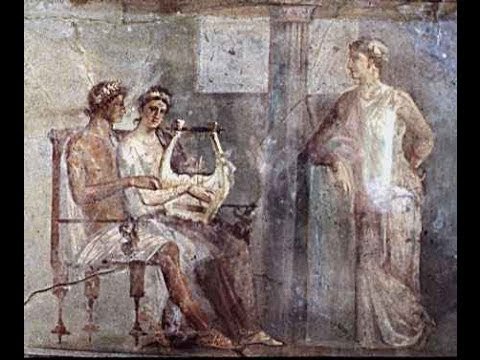This captivating panel, once thought to depict a music lesson, is now widely understood to portray a tender scene of love set within a domestic environment. It features a woman playing a kithara, an ancient stringed instrument akin to a lyre, while her lover gazes at her adoringly. Captured in the heart of Pompeii during the Roman period (50-79 CE), this intimate artwork offers a rare glimpse into the private lives of Romans and invites us into their world of love, art, and emotional connection.
A Glimpse into Roman Domestic Life
The panel, now preserved in the British Museum, provides an invaluable look at Roman social and family dynamics. In Roman society, love and music were deeply intertwined, as music was not only an art form but also a means of enhancing personal relationships. While earlier interpretations suggested the scene represented a music lesson, modern scholarship points to a more profound reading. The image now seems to celebrate the tender bond between the woman and her lover, underlining the ways in which music can express affection and beauty.

The Role of Music in Roman Society
The kithara, a prominent instrument in Roman culture, is more than just an accessory in this depiction. It represents the cultural value of music, which was integral to both public and private life. In the Roman context, music was not merely entertainment; it held deep social significance. Musicians were revered, and performances, especially in intimate settings, were seen as a way to forge connections, express emotions, and even reflect one’s status and sophistication.
In the scene, the woman’s performance with the kithara suggests that her musical talent is a symbol of both beauty and allure, qualities often celebrated in Roman art. Her lover’s gaze conveys admiration, not only for her music but for her presence, embodying the Roman ideal of romantic devotion.
Symbolism of Love and Music
This depiction highlights the Romans’ appreciation for love as a powerful, yet intimate force. Music and love were often linked in Roman culture, with many poets and artists exploring their connections in literature and art. In this panel, the couple’s interaction—especially their gaze toward one another—suggests that music was not only a form of entertainment but a language of affection. It symbolizes a deeper emotional bond, which resonates with the broader themes of Roman art that celebrate human connection and beauty.

The idea of romance conveyed through music was a frequent subject in Roman literature, where poets like Catullus often wrote about the power of song to express desire and passion. Similarly, visual arts like this panel encapsulate the ways Romans used art to explore personal relationships and social ideals.
Artistic and Cultural Significance
The craftsmanship of the panel reflects the sophistication of Roman decorative techniques. The focus on realistic human emotion and expression, coupled with the careful use of color, adds emotional depth to the scene. Roman artists were known for their ability to capture lifelike expressions and moments of intimacy, and this piece is no exception. By preserving such domestic scenes, we gain insight into the everyday lives of ancient Romans, far beyond the grand architecture and monumental public works for which the empire is often known.
Additionally, this artwork sheds light on how art and culture intertwined in Roman society, where everyday experiences—such as love, family life, and personal passions—were often immortalized in public and private art forms. Music, especially, became a way to communicate emotions that words alone could not express.
Conclusion: A Timeless Connection
In sum, this remarkable artwork from Pompeii exemplifies the technical skill of Roman artists while also revealing the cultural significance of love and music in Roman society. The enduring appeal of this panel lies in its ability to connect us with the ancient past, offering a rare glimpse into the lives of people who, like us, found beauty and meaning in the tender moments of love and artistic expression. The themes of affection, artistry, and connection continue to resonate with audiences today, reminding us of the timeless nature of human emotions.
As this artwork endures through time, it serves as a testament to the sophisticated, emotionally rich culture of ancient Rome and underscores the importance of art in preserving the stories of love and life.

